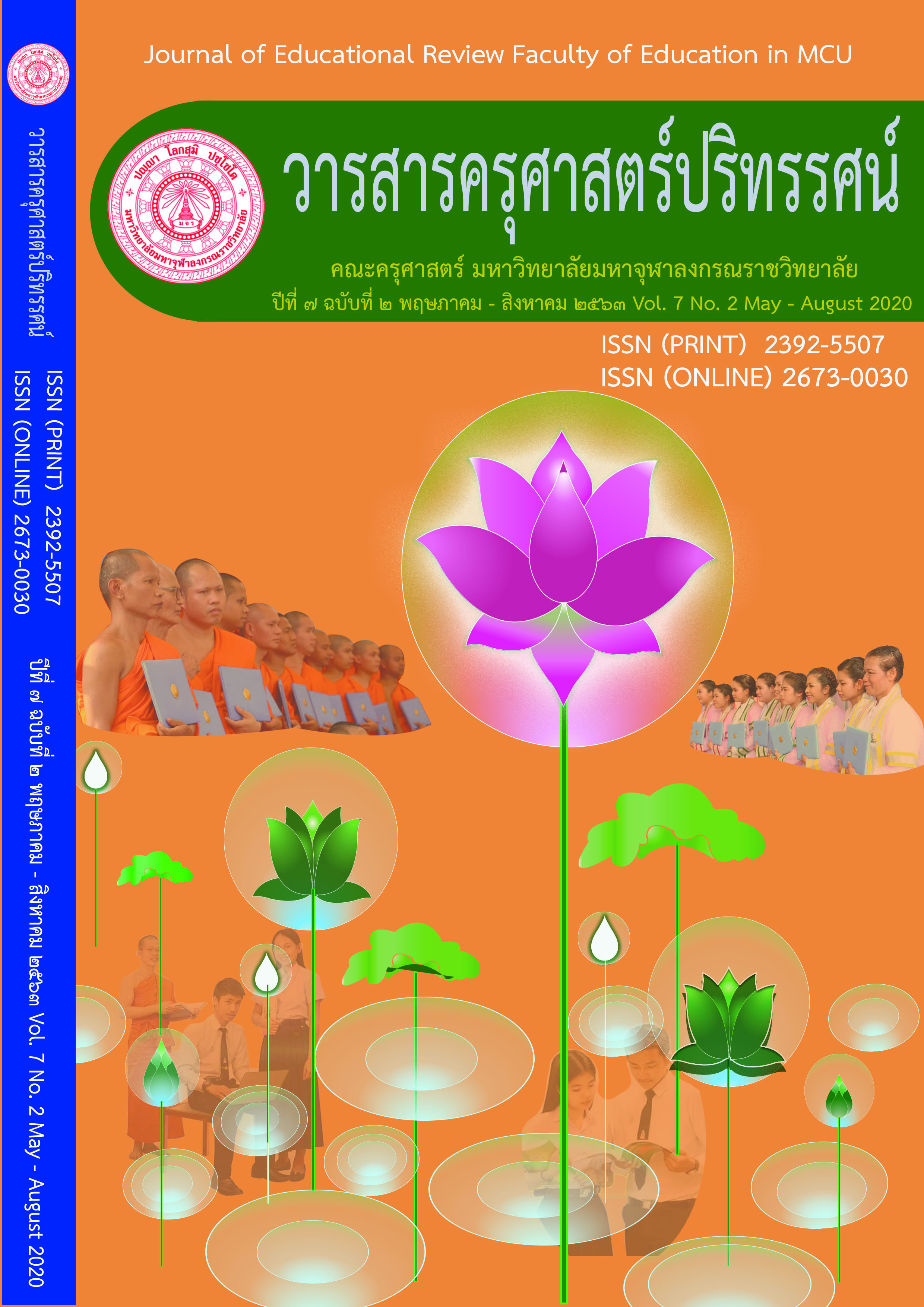A CAUSAL RELATIONSHIP MODEL OF FACTORS AFFECTING THE PROFESSIONAL LEARNING COMMUNITY IN PRIMARY SCHOOLS UNDER THE OFFICE OF THE BASIC EDUCATION COMMISSION IN THE NORTHEAST OF THAILAND
Main Article Content
Abstract
The purposes of this research were 1) to study the causal relationship model of factors affecting the Professional Learning Community of primary schools 2) to examine the consistency of the causal relationship model of factors that affect is the Professional Learning Community of primary schools with empirical data conducting. The research divided into two phases. The phase 1 was to defining the conceptual research framework by analyzing documents and related research interviews with seven experts and three outstanding schools. Moreover, the phase 2 was investigating research hypotheses data collection. The sample group consisted of primary school principals and primary school teachers under and the amount 626 people were selected by multi-stage random sampling. The data were analyzed by frequency, percentage, mean, standard deviation, and the Pearson product-moment correlation coefficient and analyze the causal relationship model. The research findings were as follows: 1) Factors affecting the Professional Learning Community of primary schools, consisting of 5 factors which are Climate and culture, School structure, Transformational leadership, Vision and mission and Personnel and teams. 2) The developed model is consistent with the empirical data. The statistical values are as follows: χ2 = 158.37, p-value = 0.21, df = 145, χ2/df = 1.09, RMSEA = 0.01, GFI = 0.98, AGFI = 0.95. From the path analysis is as follows: The direct effect found that Personnel and teams had the most direct effect on being the Professional Learning Community of the school, followed by School structure. The indirect effect found that Climate and culture indirectly influence the community on being the Professional Learning Community of the school. Moreover, the total effect found that Climate and culture had the most influence on being the Professional Learning Community of the school, followed by Personnel and team, School structure and transformational leadership respective. When considering the prediction coefficient (R2) of the four causal factors, they can jointly explain the variance of being the Professional Learning Community of the primary schools at 40.00 percent
Article Details
ทัศนะและความคิดเห็นที่ปรากฏในบทความในวารสารฉบับนี้ถือเป็นความรับผิดชอบของผู้เขียนบทความนั้นเพียงผู้เดียว และไม่ถือเป็นทัศนะและความรับผิดชอบของกองบรรณาธิการ
กองบรรณาธิการขอสงวนสิทธิ์ในการคัดเลือกบทความลงตีพิมพ์และจะแจ้งให้เจ้าของบทความทราบหลังจากผู้ประเมินบทความตรวจอ่านบทความแล้ว
ต้นฉบับที่ได้รับการตีพิมพ์ในวารสารครุศาสตร์ปริทรรศน์ คณะครุศาสตร์ มหาวิทยาลัยมหาจุฬาลงกรณราชวิทยาลัย ถือเป็นกรรมสิทธิ์ของคณะครุศาสตร์ มหาวิทยาลัยมหาจุฬาลงกรณราชวิทยาลัย ห้ามนำข้อความทั้งหมดหรือบางส่วนไปพิมพ์ซ้ำ เว้นเสียแต่ว่าจะได้รับอนุญาตจากมหาวิทยาลัยฯ เป็นลายลักษณ์อักษร
References
กรองกาญจน์ นาแพร่. (2560). การเป็นชุมชนการเรียนรู้ทางวิชาชีพที่ส่งผลต่อประสิทธิผลการบริหารงานวิชาการในโรงเรียนประถมศึกษาของรัฐ จังหวัดสมุทรสาคร. วิทยานิพนธ์ครุศาสตรมหาบัณฑิต. มหาวิทยาลัยราชภัฏนครปฐม.
กัญญาภัค เฮงใจบุญ. (2555). การวิเคราะห์ปัจจัยเชิงสาเหตุที่มีอิทธิพลต่อการเป็นองค์การแห่งการเรียนรู้ของสถานศึกษาขั้นพื้นฐาน สังกัดสำนักงานเขตพื้นที่การศึกษาประถมศึกษา. ดุษฎีนิพนธ์การศึกษาดุษฎีบัณฑิต. มหาวิทยาลัยอีสเทิร์นเอเชีย.
ดรุณี โกเมนเอก. (2553). รูปแบบความสัมพันธ์ของปัจจัยเชิงสาเหตุต่อการเป็นองค์กรแห่งการเรียนรู้ของมหาวิทยาลัยราชภัฏ. ดุษฎีนิพนธ์ปรัชญาดุษฎีบัณฑิต. มหาวิทยาลัยคริสเตียน.
ธันยพร บุญรักษา. (2553). ปัจจัยที่ส่งผลต่อการเป็นชุมชนแห่งการเรียนรู้ของโรงเรียนในสังกัดองค์กรปกครองส่วนท้องถิ่นในจังหวัดเลย. วิทยานิพนธ์ครุศาสตรมหาบัณฑิต. มหาวิทยาลัยราชภัฏเลย.
นงลักษณ์ วิรัชชัย. (2542). โมเดลลิสเรล : สถิติวิเคราะห์สำหรับการวิจัย. พิมพ์ครั้งที่ 3. กรุงเทพมหานคร: โรงพิมพ์จุฬาลงกรณ์มหาวิทยาลัย.
วรลักษณ์ ชูกำเนิด. (2557). รูปแบบชุมชนการเรียนรู้ทางวิชาชีพครูสู่การเรียนรู้ในศตวรรษที่ 2 บริบทโรงเรียนในประเทศไทย. ดุษฎีนิพนธ์ศึกษาศาสตรดุษฎีบัณฑิต. มหาวิทยาลัยสงขลานครินทร์.
วิจารณ์ พานิช. (2555). วิถีสร้างการเรียนรู้เพื่อศิษย์ในศตวรรษที่ 21. กรุงเทพมหานคร: ตถาตาพับลิเคชั่น.
วิโรจน์ สารรัตนะ. (2548). โรงเรียนการบริหารสู่ความเป็นองค์การแห่งการเรียนรู้. กรุงเทพมหานคร: อักษราพิพัฒน์.
ศศกร ไชยคำหาญ. (2550). ปัจจัยทีมีอิทธิพลต่อการเป็นองค์การแห่งการเรียนรู้ของสถานศึกษาขั้นพื้นฐาน. ดุษฎีนิพนธ์ปรัชญาดุษฎีบัณฑิต. มหาวิทยาลัยศิลปากร.
สำนักงานเลขาธิการสภาการศึกษา. (2560). สภาวะการศึกษาไทยปี 2559/2560 แนวทางการปฏิรูป การศึกษาเพื่อก้าวสู่ยุค Thailand 4.0. กรุงเทพมหานคร: สำนักงานเลขาธิการสภาการศึกษา.
สุเทพ พงศ์ศรีวัฒน์. (2555). ผู้นำสถานศึกษากับการสร้างโรงเรียนแห่งการเรียนรู้. แหล่งที่มา http://www.suthep.ricr.ac.th. สืบค้นเมื่อ 11 ธ.ค. 2560.
อมรา จำรูญศิริ. (2555). รูปแบบความสัมพันธ์โครงสร้างเชิงเส้นของปัจจัยที่ส่งผลต่อการเป็นชุมชนแห่ง การเรียนรู้ของโรงเรียนสังกัดสำนักงานคณะกรรมการการศึกษาขั้นพื้นฐานในภาคตะวันออกเฉียงเหนือ. ดุษฎีนิพนธ์ปรัชญาดุษฎีบัณฑิต. มหาวิทยาลัยราชภัฏเลย.
DuFour, R., Eakey, R., and Many, T. (2006). Learning by Doing. A Handbook for Professional Learning Communities at Work. Bloomington. IN: Solution Tree Press.
Hoy, W. K. & Miskel, C.G. (2001). Educational administration: Theory research and practice. 6th ed. New York: McGraw-Hill.
Leithwood, K., & Jantzi, D. (2006). Transformational school leadership: Its effects on students, teachers and their classroom practices. School Effectiveness and School Improvement. 17(2). 201-227.
Thompson, S. C. Gregg, L., & Niska, J. M. (2004). Professional learning communities, leadership, and student learning. From http://www.nmsa.org/Publications/RMLEOnline/Articles. Retrieved May 10, 2004.


